What is human centric lighting
Human centric lighting (HCL) is the science of composing light recipes that dynamically anchor human circadian rhythms to the 24-hour external environment cycle to support health, well-being and performance while addressing the visual needs to see, perceive and interact with the surrounding environment. Light is a fundamental part of life. The axial rotation of the earth delivers the natural sequence of day and night. From dawn to dusk, the moving sun creates progressive variations in color and intensity. During the night, our ancestors relied on moonlight, starlight and firelight to spend the evening. Under the influence of the ebb and flow of daylight and darkness humans developed the circadian system that has been genetically entrained to the 24-hour light/dark cycle and keeps track of the subtle changes in environmental light. The 24-hour rhythm of the ambient changes does not just impact the visual system, it also has a profound effect on a multitude of neuroendocrine and neurobehavioral responses.
Human circadian rhythms
The naturally evolved circadian rhythms in humans and other living organisms are self-sustaining oscillations that repeat themselves at a period of approximately 24 hours. Circadian oscillations exist in nearly all behavioral and physiological processes such as sleep/wake cycles, body temperature, hormone production, neurotransmitter secretion, blood pressure, cardiac metabolism, digestion, glucose homeostasis, gene expression, and cell-cycle regulation. These processes are regulated by internal biological clocks composed of specific molecules (proteins).
The circadian timing system is comprised of a master clock and a group of peripheral clocks. The master clock, sometimes called central pacemaker, is located in the suprachiasmatic nucleus (SCN) of the brain’s hypothalamus. Peripheral clocks are cellular oscillators that interact with peripheral tissues and organs throughout the human body. As the name suggests, the master clock synchronizes all the peripheral clocks which in turn provide local time-keeping within tissues/organs and drive rhythmicity in tissue-specific genes and processes. In addition to entraining them to the external environment by acting as the master clock, the SCN also performs as a peripheral-clock coordinator. It regulates the sequential and phase-relation ordering of various metabolic, physiological and behavioral functions to avoid the simultaneous occurrence of conflicting behaviors or conflicting cellular functions.

The master and peripheral biological clocks
The circadian system is organized in a hierarchical architecture in which the SCN orchestrates the cellular oscillators. The SCN is the body’s only clock that generates self-sustaining, endogenous oscillations. In absence of the SCN, the peripheral clocks will be out of phase with the external day/night rhythm or with each other. The free-running period of the SCN is slightly greater than 24 hours. Environmental time cues must be able to reset (phase-shift) this endogenous clock to ensure the physiological functions and neurobehavioral mechanisms are appropriately synchronized with the outside world. Failure to synchronize the master clock with the external environment will result in desynchronization of internal and external time, causing a cascade of negative effects to spread out through the body. Circadian desynchronization can disrupt the normal release of hormones such as melatonin and cortisol, cause disturbances in sleep patterns, suppress oscillations of clock gene expression associated with cancer and diabetes, and affect cell metabolism and proliferation.
Nocturnal melatonin production is an important component of internal synchronization. Melatonin is a lipophilic hormone secreted into the blood by the pineal gland. It acts as a transmitter that relays information about photoperiod (provided by the SCN) to peripheral clocks. Acute melatonin suppression or a change in the timing of melatonin secretion can impair the interaction between the master clock and cellular oscillators, leading to circadian disruption. Melatonin is not only an internal synchronizer of the peripheral clocks with the SCN, but also considered a potent cytoprotective agent that has the antioxidant capacity to scavenge free radicals, stimulate antioxidant enzymes and limit oxidative stress inside cells.
Consequences from circadian disruption
Numerous negative implications are associated with impaired synchronization of the master clock to environmental time cues and internal circadian desynchronization due to disrupted melatonin secretion. Consequences from circadian disruption range from compromised well-being and performance in the short term to severe health problems in the long term. They can include cancers, increased rates of tumor growth, metabolic syndrome, cardiovascular problems, hypertension, bone‑related diseases, impaired functioning of the immune system, cognitive decline, thyroid dysfunction, inflammatory disorders, neurological disorders, chronic fatigue, mood disorders (depression, schizophrenia, attention deficit), diabetes and obesity.
At both the molecular and the physiological levels the SCN and the sleep-wake system mutually regulate each other. Disruption of circadian rhythms may cause them to interact in a vicious circle, which leads to serious implications. Maintaining well-regulated circadian rhythms is therefore paramount to the body’s efficient and appropriate functioning.
The human body is hardwired with external lighting dynamics
The natural sequence of day and night is the major environmental time cue that resets the master biological clock. Photoreceptors in the retina of the eye capture optical radiation information input from the surrounding environment and send the transduced signals to the SCN. Apart from the classical photoreceptors—rods and cones—which also participate in circadian phototransduction, a third class of retinal photoreceptors called intrinsically photosensitive retinal ganglion cells (ipRGCs) are central to circadian phototransduction. The ipRGCs are widely distributed throughout the retina. This broad dendritic arborization allows the photoreceptors to integrate photic input from a large area of the retina and deliver information about the overall environmental irradiance to the SCN.
The ipRGCs transduce optical radiation stimuli into neural signals for the master biological clock via a direct pathway called the retino-hypothalamic tract (RHT). The photosensitivity of the ipRGCs is driven by a photopigment known as melanopsin. Melanopsin is maximally sensitive to short-wavelength blue-cyan light, with a peak around 460-480 nm. This action spectrum happens to be a significant component of daylight. In simple terms it can be assumed that the ipRGCs react only to daylight and to light that is similar in spectrum and intensity to daylight.
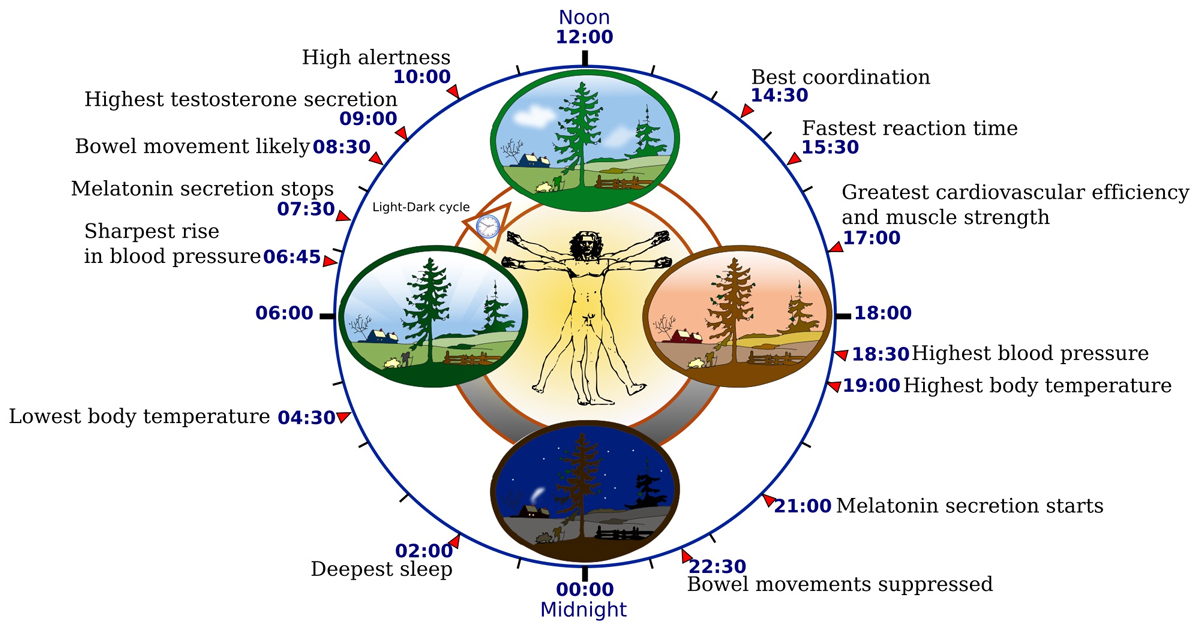
The daylight-dependent regulation of human physiological responses
As the sun rises and the day begins, the spectral power distribution (SPD) of the daylight shifts toward the blue part of the spectrum and the color of the light appears cooler until the noontime. As the day progresses through afternoon and evening, the natural light gradually changes its color from cool to warm as the radiant energy becomes stronger in the red part of the spectrum. Accompanying the spectral shift is the changes in illuminance levels.
During the daytime period, the bright, blue-enriched light signals the SCN to enhance cortisol, dopamine and serotonin production while suppressing melatonin secretion to stimulate daytime physiological responses. The secretion of cortisol begins to rise at the mid-point of sleep and peaks in the morning to promote wakefulness, stimulate the metabolism and enable stress responses. Cortisol production dims as the day progresses. Dopamine is secreted for creating sensations of pleasure and improving alertness and muscle coordination. Serotonin acts as a mood stabilizer, contributes to feelings of happiness and plays a role in cognition (e.g., memory and learning).
As the sun descends in the west, the level of illuminance and blue content in the ambient light declines. During the nighttime, the absence of blue light or complete darkness provides a night signal to the SCN which then transmits the command to the pineal gland to secrete melatonin into the blood. Melatonin secretion starts to climb around 9 PM, peaks around 2 AM, and ceases by 7 AM. The biological night defined by melatonin secretion is essential for a restorative sleep and long-term health.
A large population is exposed to the greatest risk of circadian disruption
The circadian timing system has genetically evolved to rely on the use of predictable environmental changes for clock calibration. Today, however, people spend a significant portion of their day indoors. Artificial lighting that people work and live under has been designed to fulfill the visual needs only. There are five important characteristics of light that influence the circadian systems. They are intensity, spectrum, timing, duration, and distribution. These characteristics are variables that change dynamically over the course of the day.
Among these variables, the spectrum is at the core of the interaction between natural light and the body’s biological processes. Traditional lighting systems operate with a static spectrum and therefore are unable to create ambiances that reflect the characteristics of exterior daylight. Circadian entrainment is also plagued by the influences of people lifestyle choices (e.g., exposure to blue-enriched light emitted from smartphones or tablets at night), working night shifts, living in locations with urban light pollution, the aging of the circadian system, etc. The lack of regular optical radiation input that is aligned with the different phases of a 24-hour solar day puts a significant percentage of the global population at risk of circadian disruption and subsequent adverse effects.
What does human centric lighting do
Human centric lighting is designed to bring the dynamics of outdoor ambiance into indoor environments. It simulates the changing spectrum and intensity of natural light to provide the drama and variety that facilitate circadian entrainment, enhance visual performance and create an immersive experience. Through integration of four dynamically controllable light characteristics—intensity, color, timing and duration, human circadian rhythms are kept in synchrony with the daily rhythms in its external environment in the absence of external cues.
HCL supports long-term health and wellness by driving fundamental aspects of molecular and physiological function in the brain and body to strengthen the immune system, support cell regeneration and energy metabolism, stimulate circadian clock gene expression, and maintain a healthy sleep-wake cycle. It may also be used to exert immediate influence for enhanced performance, productivity, and environmental comfort.
With flexible control on lighting, positive physiological and psychological responses can be engaged straight away during the working and learning hours. These include acute effects such as suppressing pineal melatonin secretion, elevating morning cortisol production, increasing subjective alertness, heightening mood and feelings of reward and motivation, enhancing psychomotor performance, changing brain activation pattern, increasing core body temperature, improving muscle coordination, elevating heart rate, and activating pupil constriction.
The concept of human centric lighting applies to any indoor environment beyond the residential and office spaces. In healthcare facilities HCL can be tuned to treat circadian disorders and shift the timing of the circadian clock in night workers. Hospitality and retail facilities capitalize on HCL to create an engaging experience and promote well-being. Industrial facilities and workplaces use bioactive lighting to maximize efficiency and productivity. HCL is implemented in educational facilities to improve concentration and cognition during classroom learning periods and testing times.
The biological influence of blue light

Among the different wavelengths that are mixed to form white light, it is predominantly the blue wavelengths that exert control over human physiological processes. Due to this fact, blue-enriched white light is also termed as biologically effective light. Blue photons incident on the retina prompt the SCN to evoke daytime physiological responses by suppressing melatonin production, stimulating enhancing the secretion of cortisol, dopamine and serotonin, and elevating core body temperature (CBT).
Just as the presence of ipRGC-reactive blue light is critical to programming the body for day mode, the absence of the blue component is critical to defining biological night during which melatonin production is activated to trigger a chain reaction that ensures a refreshing sleep, provides a vital protective mechanism for the immune system and supports essential regeneration. Dynamically controlling the spectrum of white light to adjust the amount of blue radiation is a fundamental philosophy in HCL implementation. However, long wavelength optical radiation (or blue-depleted light) at a sufficiently high irradiance can acutely suppress melatonin production, despite its diminished capacity to induce neuroendocrine and nurobehavioral reponses. Intensity control is, therefore, an equally important part of HCL implementation.
A holistic approach is necessary to deliver human centric lighting
A human centric lighting system or solution is a group of interacting or interrelated elements that are organized to enable holistic design of the visual, physiological and psychological effects of light. It integrates lighting, intelligence and networking to provide dynamic, programmable and self-adapting lighting that allows the phase and amplitude of the circadian pacemaker to optimized.
HCL takes advantage of the extraordinary capabilities afforded by the convergence of connected lighting based on LED technology and the Internet of Things (IoT). The foundational technology underlying breakthroughs in HCL is LED lighting which employs the principle of injection electroluminescence to produce light.
The semiconductor emitters known as light-emitting diode (LEDs) release radiant energy the visible wavelength range through recombination of electrons and holes in the active layers (quantum well structures) between the p–n junction. Through bandgap manipulation of the quantum wells, LEDs can be designed to emit narrow-band emissions (monochromatic light, e.g., red, green, blue) throughout the entire electromagnetic spectrum. The monochromatic LEDs can be spread in wavelength using a phosphor converter to create full spectrum white light in a wide correlated color temperature (CCT) range. The availability of miniature LEDs in any colors and CCTs makes it possible to create additive color mixing systems not possible with incandescent and fluorescent lighting.
Instantaneous dimming of LEDs over a full range of intensity provides the ability to deliver the right amount of light on demand for dynamic color mixing and luminance adjustment. The exceptional on/off/dimming capabilities of LEDs also allow seamless integration into electronic circuits that provide sensing, data processing and network communication.
Tunable white LED lighting
Human centric lighting is implemented through the use of tunable white lights. A tunable white light is a multi-channel LED luminaire that provides a dynamically controllable spectrum of white light and allows to change the intensity of the light via a separate control input. The luminaire is equipped with a color mixing system formed of a combination of LED primaries in different monochromatic colors or different color temperatures.
Color mixing systems in RGBA, RGBW or RGBAW combinations provide the ability to produce white light at any CCT across the Kelvin scale, with the chromaticity coordinates controlled to any color points, including the blackbody (Planckian) locus. Full-color tuning products are more complex to control and have a higher cost when compared with CCT-mixing systems.
A CCT-mixing system uses a minimum of two LED primaries. The adjustable CCT range is determined by the gamut or the minimum and maximum CCTs of phosphor-converted LEDs. The concept of the color temperature is used to communicate the color of the emitted light and allows the percentage of bioactive blue energy in the light spectrum to be intuitively correlated with. The lower the CCT, the warmer the color, and the lower the blue content. The higher the CCT, the cooler the source appears, and the higher the blue content.
Warm white light is heavily laden with energy at red and orange wavelengths. In contrast, cool white light is blue-enriched. The most basic configuration is a mix of warm white LEDs (usually around 2700K) and cool white LEDs (usually around 6000K). With 2-channel CCT mixing, however, the chromaticity coordinates follow a straight line between chromaticity points of each CCT LED. Those in the middle of the mixing range deviate from the blackbody locus.
The wider the mixing range, the larger this deviation becomes. One or more additional primaries, depending on the mixing range, should be added to ensure shifting of the color points along the blackbody locus. Tunable white LED luminaires are required to produce consistent chromaticities with no more than a 2 SDCM (standard deviation color matching) variation along the tuning path. To produce white light in predictable colors from a multi-channel LED system, each of its component LED channels must be individually, accurately dimmed. Dimming of the LEDs is accomplished through either pulse-width modulation (PWM) or constant current reduction (CCR).
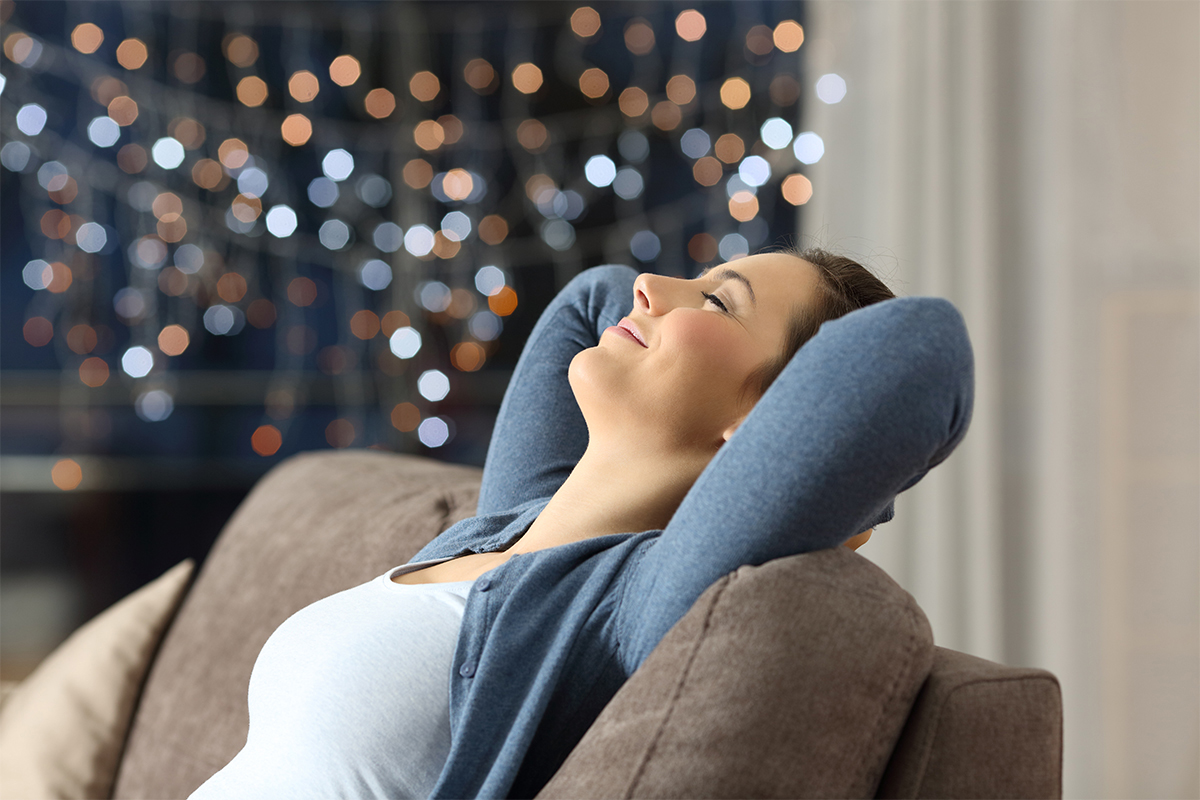
The convergence of hardware, network, and software
To participate in human centric lighting, tunable white lights need to be smart, intelligent, and connected. Adding sensing, computing and networking capabilities to tunable white lighting systems enables them to communicate with people and the environment, allowing the spectrum and intensity of light to be flexibly adapted to the changing contexts.
At the heart of a smart LED system is the digital lighting controller which incorporates processors, computer memory, input/output (I/O) ports and network interfaces. It hosts and runs software and algorithms to perform data acquisition, data communication and data processing and then executes instructions from the network controller or actions based on pre-programmed algorithms or specific sensor data. The controller operates the LED driver, which in turn dim or switching the LEDs. The integrated network interface allows the controller to run communication protocols and connect to a computer-controlled network.
Migrating lighting control to IP-based network infrastructure opens the door to a plethora of new possibilities and services offered by the IoT. The IoT is an extension of the Internet. It is an agglomeration of various technologies (such as cloud computing, big data, artificial intelligence and machine learning) and a vast network of connected devices that work in tandem to provide actionable information and cloud processing power. Connecting to IoT platforms and bringing IoT insights into everyday living and work environments promise to deliver immense value for human centric lighting.



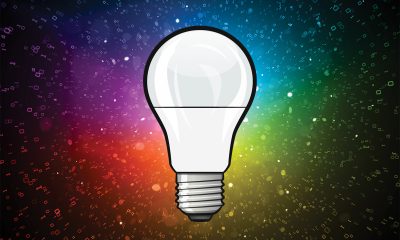
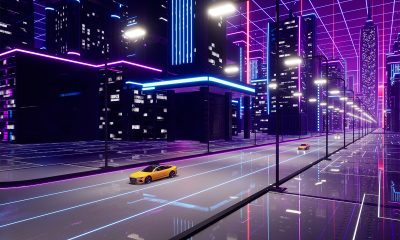
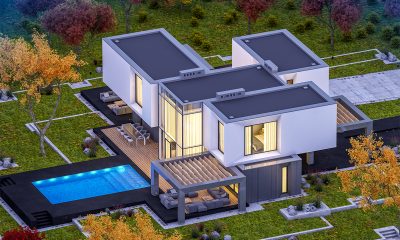

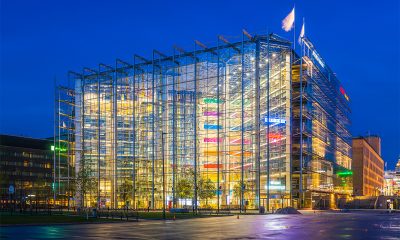

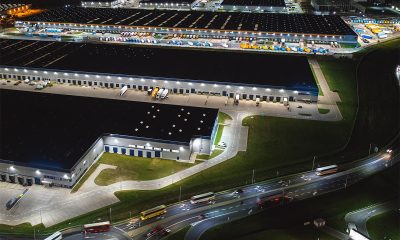


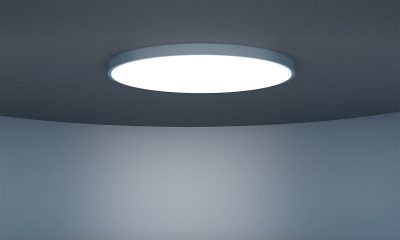
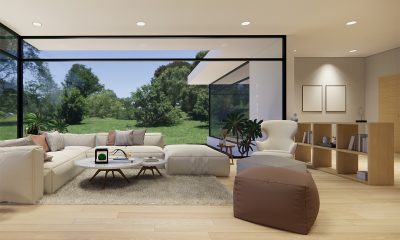





Loading...